Skin conditions are among the most frequent reasons dog parents have to take their babies to vet clinics. Skin issues are common among dogs and can cause a lot of discomfort to your dog, ranging from soreness to itching. It is during the warmer season that these issues become more apparent.
It is when seasonal allergies such as plants, pollens, and insect bites happen more often. Hence, the symptoms become more prominent during this season. You must pay attention to any skin issue your dog may face, even where they appear not so noticeable.
Skin conditions can be of different types. It includes allergies caused due to parasites, fungal infections, and bacteria. Some types of skin conditions are caused by Impetigo, food-related allergies, Mange, Ringworm, fleas and ticks, environmental allergies, folliculitis, etc.
It is significant to watch out for the signs and symptoms to get the appropriate treatment to support the skin and coat health of the dog.
10 Most Common Skin Problems in Dogs
#1 Environmental allergy
If your dog has a sudden onset of itching, especially in their face, chest, feet, and stomach, it can be a sign of an environmental allergy. It is a skin condition triggered when your dog comes in contact with the factor that is irritating in the first place. This specific kind of allergy in dogs is also referred to as atopy and is similar to hay fever, which even human beings suffer from.
The difference is that dogs show irritated and itchy skin instead of sneezing and watery eyes.
Some of the common allergens that cause skin irritations and inflammations are the following:
- grass
- dust mites
- pollen
In these cases, the doctor would perform a blood test to determine whether they are having a reaction or not. At times, treating such allergies tends to become difficult. In the severest of cases, doctors may recommend the following modes of treatment:
- shampoos
- medicinal dips
- anti-inflammatory medicines
- tablets
- injections
#2 Food allergies
If your dog is incessantly itching their face, ears, feet, and anus, it is a sign that it may be suffering from a food allergy. It is also one of the common skin conditions in dogs. Dogs might develop food allergies because of the kind of protein they have consumed as part of their diet, such as the following:
- beef
- eggs
- chicken
- dairy
Some dogs also suffer from allergies when they consume wheat and vegetables! As humans suffer from food intolerance, dogs also get subjected to an elimination diet of 8-12 weeks.
Read Also: Home Remedies To Treat Your Dog’s Itchy Skin
#3 Folliculitis

The meaning of the word folliculitis is inflammation in hair follicles, and it often happens when your dog is already suffering from other skin issues like skin allergies or management. The underlying skin condition infects the hair follicles. It appears on their body in the form of the following all over their skin:
- sores
- bumps
- scabs
Your vet could prescribe any or all of the following to help soothe and treat the infection:
- shampoos
- oral antibiotics
- antibacterial ointments
#4 Yeast infections
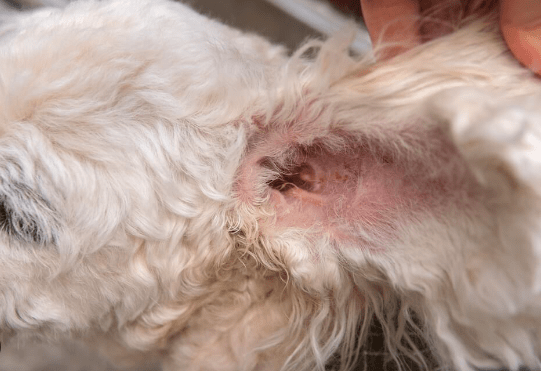
A dog’s skin can be called home to various fungi and bacteria. These organisms do not lead to any problems. It is the immune system of the dog that keeps them in check. However, when a sort of yeast known as Malassezia infests a dog’s skin, it grows out of control.
As a result, it irritates their skin and leads to inflammation, but such infections are not contagious. However, if they infect their ears, they can make them deaf too!
#5 Dry skin
The typical characteristic of dry skin in dogs is flaking, and if they are scratching on top of it could be accompanied by scratching. Now, there are several reasons why your dog could be suffering from dry skin, such as the following:
- issues with their diet
- allergies
- environment
If your dog needs sufficient fat, it could lead to the above problem. Your dog could also develop the problem because of an allergic reaction to common allergens such as the following:
- food
- shampoo
- dust
- smoke
- mold
#6 Skin cancer
If you see a lump or growth on the skin of your furball, you must take them to the vet as soon as possible. Lumps and skin growths are common in dogs, especially when they age, but not all conditions are cancerous.
The vet would have to diagnose correctly since finding out the kind of growth that said lump is complex. Many cancers can be treated, provided they get diagnosed early.
Read Also: Dog Skin Cancer: Natural Options That Work
#7 Flea bites
If fleas bite your dog, they contract a skin condition called flea allergy dermatitis. The most prominent symptoms of the skin condition may be enumerated below:
- inflamed skin
- bald spots
- increased licking
There is a high chance the area where they get bitten by the insect would have infected sores. Doctors say that if your dog is bitten by other ectoparasites, such as ticks and mites, it can cause similar reactions in them.
#8 Impetigo
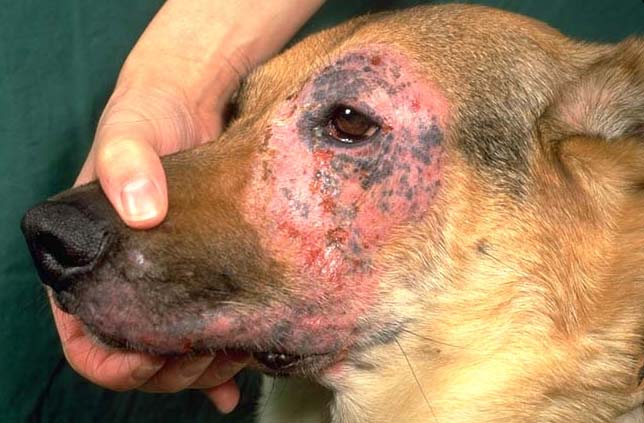
Impetigo is more common among pups than adult dogs because of another underlying skin condition. These lesions might appear in blisters on your puppy’s stomach that can scab over and burst.
As you do with any condition such a young baby may suffer, you must take them to the vet for treatment as soon as you notice this happening. The vet prescribes medicated washes or antibiotics to treat different skin-related conditions.
#9 Ringworm

You might think that ringworm is a worm, but it is not – it is a fungus, and it happens to be immensely contagious to other animals and humans. The infection from such fungus appears in the form of circular and crusty patches and can be noticed on the following parts of the dog’s body:
- head
- paws
- ears
- front legs
In such cases, your dog’s skin may also appear red and inflamed starting from the point of origin that they have inflamed with continued scratching.
#10 Acral lick dermatitis
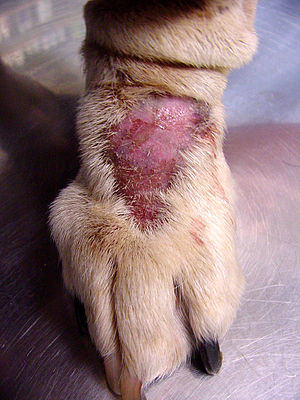
Acral lick dermatitis is a skin condition caused due to the long-term chewing or licking of the same skin area, referred to as lick granuloma. This skin issue is on the tops of their limbs or paws. The dog chews or licks the affected area because it is uncomfortable or itchy.
With time, such chewing and licking becomes compulsive and traumatizes the skin, which becomes resistant to healing. In such cases, the skin might become scarred and infected too.
There are some steps for treating the condition. The treatment starts with the diagnosis of the skin condition. It is when the vet tries to understand the reason behind the discomfort. The vet examines the affected area of the dog and the reason it is itching that part.
Read Also: Keep Your Dog’s Skin And Coat Healthy During The Winter
Conclusion
You must not let any skin condition get under your furball’s skin or your skin, for that matter. In most of these cases, prevention is significant. So, you must watch their skin health with minute inspection or grooming every week.
This way, you could make sure that the situation does not escalate where you may have to spend a lot of money and spare a lot of effort to cure the condition – in these cases, it is always better to nip the problem in the bud.
FAQs
Q: What is the usual skin allergy in dogs?
A: The common skin allergy among canines is allergic dermatitis, or atopic dermatitis and atopy. It is a persistent and inflammatory condition that happens because of the overreaction of a dog’s immune system to a specific allergen. Any of the following could cause the allergy:
- plant pollen
- mold spores
- food
- pests
Q: How many types of skin disorders are there in dogs?
A: Dogs could suffer from over 160 distinct skin disorders. Among these, some cause chronic issues too!
Q: What food causes the most allergies in dogs?
A: Various protein sources are known to cause the maximum food allergies in dogs. It includes foods such as the following:
- dairy
- beef
- chicken
- eggs
- soy
- wheat gluten
Q: What are the top foods that dogs are allergic to?
A: Dogs are commonly allergic to the following foods:
- beef
- dairy
- wheat
- egg
- chicken
- lamb or mutton
- soy
- pork
- rabbit
- fish
Q: What are common dog rashes?
A: Among the most everyday rashes dogs could suffer from is flea allergy dermatitis caused by flea bites. It is an allergic response where the dog experiences symptoms such as extreme itchiness.

 DogExpress
DogExpress

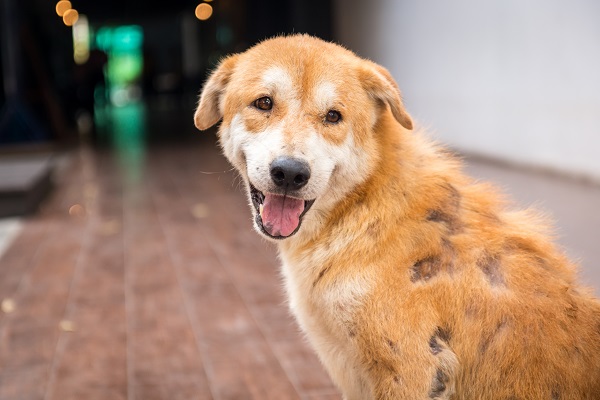





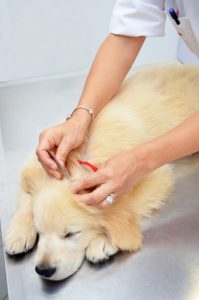
















 in Chandigarh, India.
in Chandigarh, India. 
